The Huawei P8 Review
by Andrei Frumusanu on June 4, 2015 8:00 AM EST- Posted in
- Smartphones
- Huawei
- Mobile
- P8
- Kirin 930
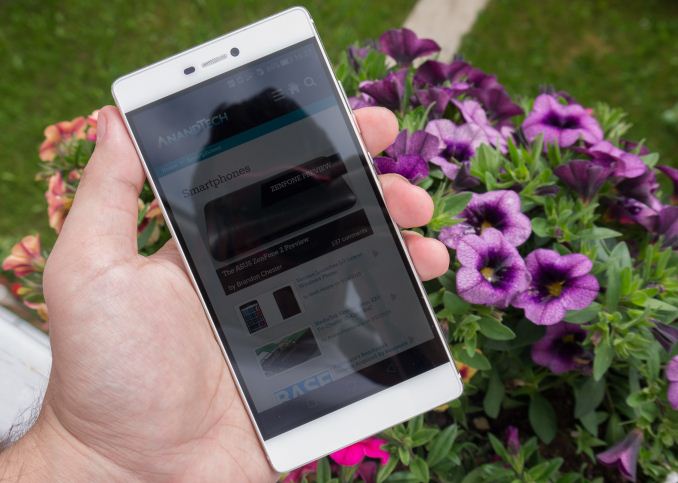
Introduction
It’s been a month now since Huawei launched its new smartphone flagship, the P8. Huawei started Ascend P-line of smartphones back in 2012 with the launch of the Ascend P1, and has since iterated every year with the follow up P6, P7, and this year’s P8. A notable deviation from the standard naming scheme is that Huawei chose to drop the Ascend brand and this year’s official name is simply the “Huawei P8”. The P-series targets the higher-end market through more robust and premium build quality, while the separate Honor brand is targeted at mainly the Chinese and other budget markets. The Mate family covers the phablet form-factor, although Huawei now also offers a super-sized P8max with 6.8” screen that kind of blurs the size segmentation.
In trying to broaden our coverage of emerging players in the mobile space, we had the pleasure of extensively covering two of Huawei’s devices over the last year – the Honor 6 and the Mate 7, so be sure to read those articles to have a good overview of Huawei’s previous efforts in terms of Emotion UI software implementations and specifics of the HiSilicon Kirin SoCs.
The P8 succeeds the Ascend P7 – both are the 5” form-factor devices aiming at the high-end segment. The P8 differs quite a lot from the P7 by ditching the glass back in favour of an all-metal unibody with rounded sides. The size also goes up a bit as the display continues to grow from 4.7” and 5” on the P6 and P7 up to 5.2” on the P8. The device gains 3mm in width and 5.1mm in height over its predecessor, reaching dimensions of 144.9 x 71.8 x 6.4mm. The device remains still very thin at 6.4mm and thus helps its ergonomics.
Before we look closer at the design choices, let’s go over the specifications of the P8’s hardware.
| Huawei P-line | ||||||
| Ascend P8 | Ascend P7 | Ascend P6 | ||||
| SoC | HiSilicon Kirin 930/935 Hi3635 4x CA53@1.5GHz, 4x CAA53e@2.0/2.2GHz Mali-T628MP4 |
HiSilicon Kirin 910T 4x CA9@1.8GHz Mali-450 |
HiSilicon K3V2 1xCA9@1.5GHz Vivante GC4000 |
|||
| Memory | 3GB LPDDR3 | 2GB LPDDR3 | 2GB LPDDR3 | |||
| Storage | 16 or 64GB NAND + microSD |
16GB NAND + microSD |
8/16GB NAND + microSD |
|||
| Display | 5.2” 1920x1080 JDI IPS-Neo LCD |
5.0” 1920x1080 IPS LCD |
4.7” 1280x720 IPS LCD |
|||
| Cellular Connectivity | GPRS/EDGE/DC-HSPA+/Category 4 LTE | GPRS/EDGE/DC-HSPA+/Category 4 LTE | 2G / 3G HSPA (EvDO China SKU) | |||
| Dimensions | 144.9 x 71.8 x 6.4 mm 144 grams |
139.8 x 68.8 x 6.5 mm 124g |
132.7 x 65.5 x 6.2 mm 120g |
|||
| Camera | 13MP (4160 x 3120) Sony IMX278 Sensor F/2.0 aperture, 29mm eq. Rear Camera w/ OIS 8MP Sony IMX179 F/2.4 aperture, 26mm eq. Front Facing |
13MP (4128 x 3096) Rear Facing Sony Sensor w/ F2.0 aperture, 8MP FFC | 8MP (3264 x 2448) Rear Facing Sony Sensor w/ F2.0 aperture, 5MP FFC | |||
| Battery | 2680mAh (10.19 Whr) | 2500mAh (9.5 Whr) | 7.6Wh | |||
| Shipping OS | Android 5.0.2 (64-bit) EmotionUI 3.1 |
Android 4.4.2 EmotionUI 2.3 |
Android 4.2.2 Emotion UI 1.6 |
|||
| Other Connectivity | 802.11a/b/g/n + BT 4.1, microUSB2.0, GPS/GNSS, DLNA, NFC |
802.11a/b/g/n + BT 4.0, microUSB2.0, GPS/GNSS, DLNA, NFC |
802.11b/g/n + BT 3.0, microUSB2.0, GPS/GNSS, DLNA |
|||
| SIM Size | NanoSIM + NanoSIM (xor microSD) |
Micro-SIM | Micro-SIM |
|||
Huawei continues to use its in-house HiSilicon-designed SoCs with the use of a new Kirin 930 or 935. The SoC is a dual-cluster piece sporting a total of 8 ARM Cortex A53 CPU cores. Differing from the usual big.LITTLE implementations were the silicon vendor would choose to use two differing CPU architectures, the Kirin 930’s use a low-frequency and leakage optimized A53 cluster paired with a high-frequency and higher leakage variant. HiSilicon calls this higher frequency core an A53e, although the piece should have no architectural differences to a traditional A53 other than an optimized physical layout to enable the higher operating frequencies.
There was some confusion as to why two SoC model numbers were referenced during the announcement of the device, but the end story seems to be is that HiSilicon brands the same piece of silicon; the Hi3635 differently based on the frequency binning it is able to reach. As such, the cheaper variants of the P8 and P8max come with the Kirin “930” with the fast A53 cluster clocked in at 2.0GHz and 16GB of NAND memory, while the more expensive models with 64GB of storage come with the Kirin “935” clocking in at up to 2.2GHz on its performance cluster. We’ve already seen this practice in the Honor 6 and Mate 7, both using the same Hi3630 chipset but branded slightly differently (Kirin 920 and Kirin 925) due to the higher clocks on the latter model.
Other than the CPU architecture change, the Hi3635 seems to differ very little to the Hi3630. We still see an ARM Mali T628MP4, running at slighter higher clocks of 680MHz. The memory sub-system is also again furbished by a 32-bit dual-channel LPDDR3-1600 memory controller design, which serves 3GB of total memory in all of the P8’s models. As expected, Huawei continues to use TSMC’s 28nm process;
HiSilicon first equipped an integrated modem in the Kirin 920, and the 930 continues this although with a slight downgrade in capability as it only supports UE Category 4 LTE speeds, reaching up to 150Mbps downstream and 50Mpbs upstream.
It’s on the camera that Huawei has undoubtedly focused most of its attention on in the P8. We had some very harsh words for the Honor 6’s and Mate 7’s camera performances, as both featured very disappointing photo and video quality. The P8 looks to change this through the introduction of a brand new Sony sensor, the IMX278. This is the second kind of implementation RGBW (Or RGBC) after the OmniVision unit found in the original Moto X. Huawei also abandons on-SoC still-image processing for a dedicated Altek external ISP. To finish things off, the camera module supports two-axis optical image stabilization with up to 2° of movement freedom. All these changes mark a significant upgrade for Huawei, and it seems to pay off for the P8, which we’ll cover in more detail in the camera section.
Design
Getting back to the P8’s design, we see an evolution of the all-metal chassis which was introduced in the Mate 7. The P8 remains a unibody design with a non-removable 2680mAh (10.19Whr) battery. The front of the phone follows the traditional slab design with the 1080p screen taking up 78.3% off the front’s footprint. It should be noted that the black frame surrounding the actual screen makes it seem as if the device’s size-bezels are much smaller than what they really are, something which is very visible on the lighter coloured models.
As opposed to the left side of the device which is barren of any feature, the right side holds the volume rocker and power button as well as the ejectable trays for the nanoSIM as well as nanoSIM/microSD combo. The volume rocker is very clicky and distinguishable from the power button, which not only has a characteristic texture on it but is also surrounded by an indent differentiating itself from the otherwise round sides. Speaking of the sides, the curvature makes for a very comfortable grip which is accentuated by bevels on the front and back.
On the top of the device we find the 3.5mm headphone jack and the top auxiliary microphone. The bottom is more interesting as the microUSB 2.0 port is flanked by two Torx screws and two symmetrical speaker grills. I tried dismantling the device by trying to remove the screws and lifting up the device's screen, but it seems that Huawei also employs additional adhesive to hold the metal shell and the screen together.
Huawei called the design a “single audio chamber speaker system”, but in practice the right grill is essentially just for aesthetics and only serves as a housing for the bottom microphone. Covering up the left grill will completely dampen the audio output of the device. Nevertheless, the P8 is still able to output very loud and clear audio with good depth.
The back of the device is accentuated by the plastic injection mold lines (which serve as dielectric dividers for the device’s antennas) at the bottom of the phone, while the top part we see a glass piece serving both as the cover glass for the camera and design element as it continues for the whole width of the device, which comes in either white for the brighter coloured phone options or black for the darker variants.
Huawei was proud to show off the ability to keep the camera flush with the rest of the phone. It seems they even managed to have some leeway here as the camera module seems to be still 1.5mm underneath the glass.
In terms of build quality it seems the P8 is a solid phone. The only gripe I’ve had with it is that it seems to have some empty space underneath the back of the phone as if you try to squeeze it will flex inwards by up to 1mm. The phone’s ergonomics are good and it was a generally pleasant device to use.
The P8 is available in two variants at each price point: 499€ for either the 16GB Mystic Champagne or Prestige Gold versions, or 599€ for the 64GB Titanium Grey or Carbon Black variants which also come with the 200MHz higher CPU clocks.


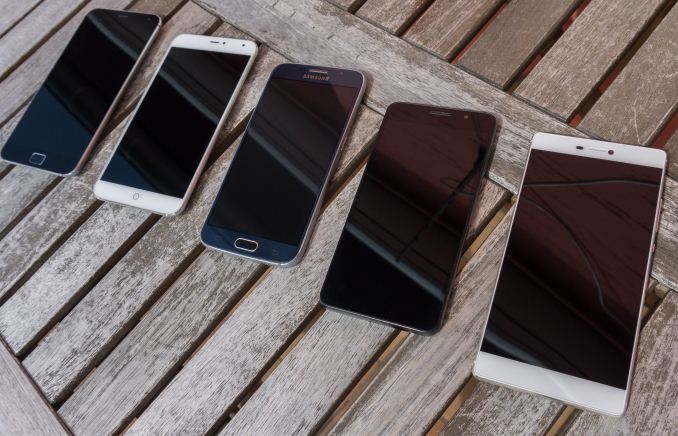

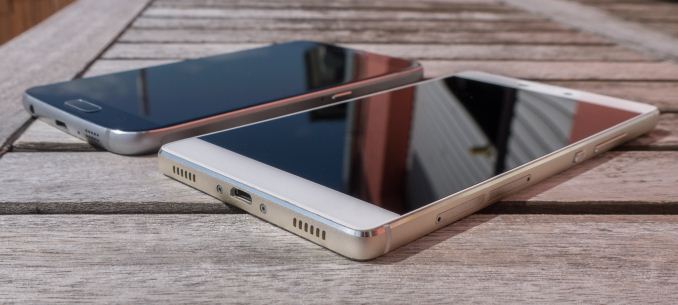
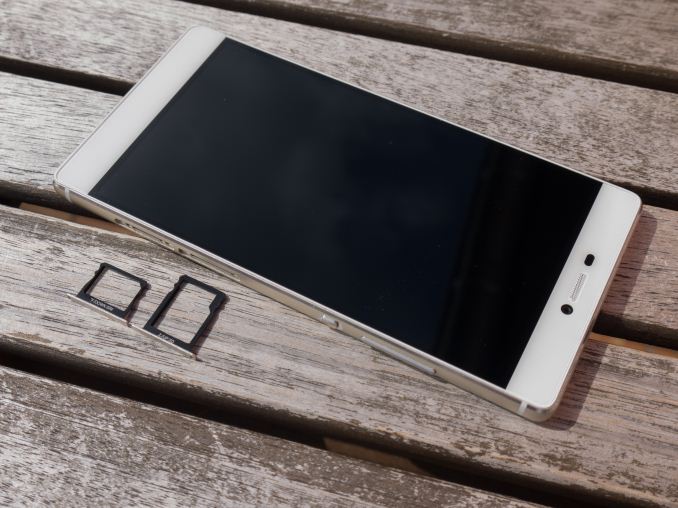
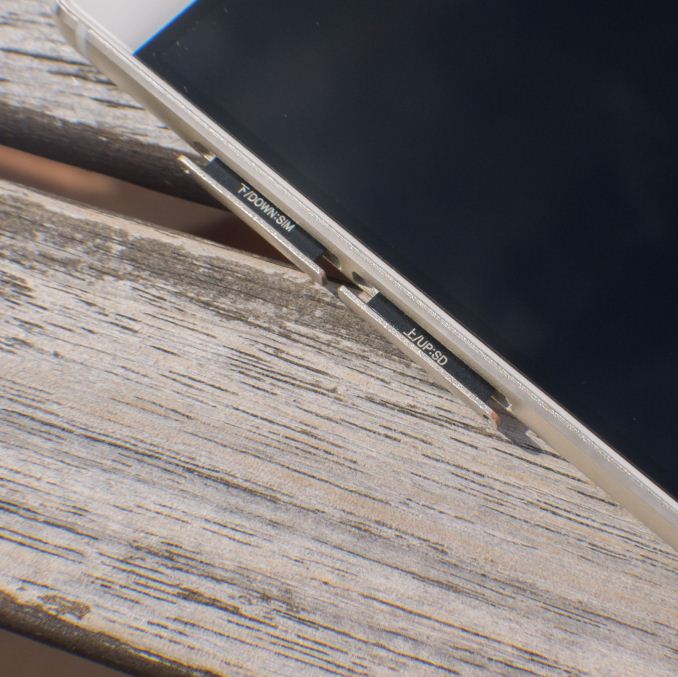
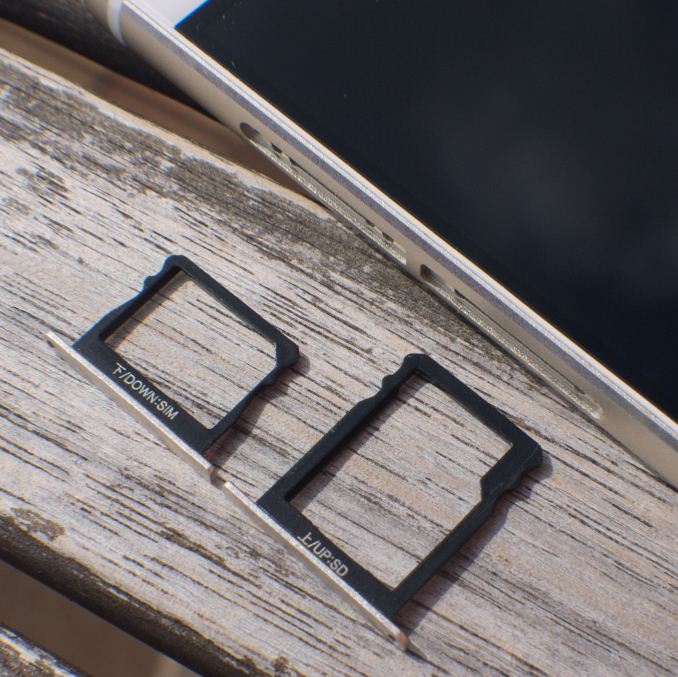


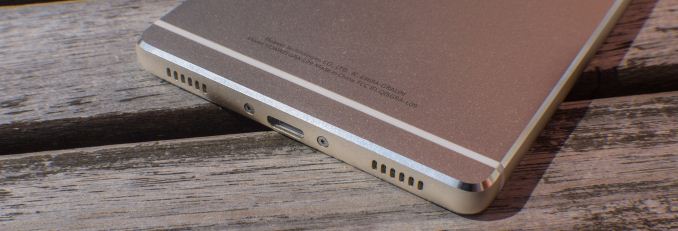

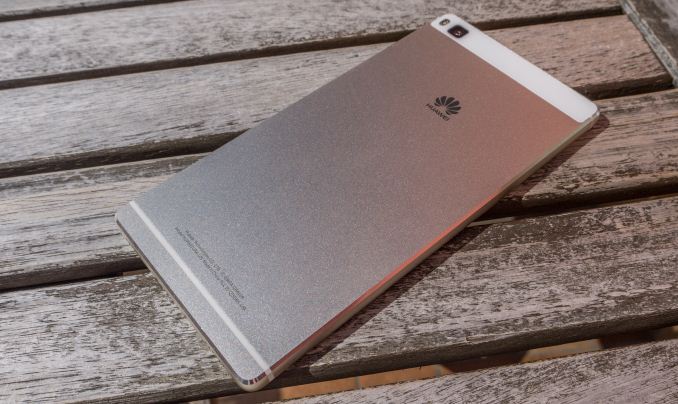
















104 Comments
View All Comments
hrrmph - Thursday, June 4, 2015 - link
It's probably more useful than an iPhone for people who travel a lot and occasionally go off the grid, and thus need the device to still work as a GPS, camera, miniature computer, etc, while drawing all data from fast, convenient local storage...- It has a MicroSDXC slot, so it can take the new 200GB MicroSD storage cards; and
- It has dual SIMS.
Unfortunately, it lacks a user removable battery, so it is still inferior in that regard to each of the phones and phablets that I already have. But, in general, I like what they are doing.
Something that other nationals can tend to forget is that China has a lot of wealthy people (far more than the US or possibly even Europe). Even though these elite Chinese are wealthy, many of them are shrewd spenders. They want value for their high-end spend. So there is a lot of pressure on Chinese vendors to produce high-end devices that include every possible feature.
So just like Japanese enthusiasts used to get certain stereos and cameras that America only dreamed of, the Chinese are demanding that the manufacturers provide more fully functional high-end phones that can do everything... including the things that the iPhone cannot do.
That said, the iPhone is making headway in China too...
... but just like in the US, it's for all the wrong reasons. Namely, it's a jewelry piece that holds sway as a status symbol amongst the more vacuous of minds. Owning one supposedly elevates your perceived social status - much in the way that owning a ludicrously expensive sports car or ultra-luxury car does the same (think Rolls-Royce, Bentley, etc.).
Sociologists and psychologists have hypothesized that such objects are attractive to both the buyers who display them publicly and to those who view them, particularly the opposite sex.
People who buy these objects are subliminally advertising to potential mates that they have excess money that (under the proper circumstances) can in the future be re-directed to caring and tending for children and non-working spouses.
The attraction effect is generally stronger if the object is purchased and displayed by a male, because many societies still expect the male to bear the larger burden of providing financial resources. This is especially the case while the female is pregnant and in the early years of caring for children that aren't yet school aged.
The larger the excess spend over the practical value, the higher the perception of excess earning capacity. That's why we sometimes see phones sold with precious jewels encrusting them. Apple is just doing the same thing on a lower level... right out of the box. Charging more than the inherent underlying value.
So it's rather refreshing to see the Chinese manufacturers taking a different approach.
And it is especially refreshing to see the Chinese doing this in light of the fact that Samsung vacated the market as an Apple competitor and have now lowered themselves to merely matching Apple's product features. Without the Chinese, the Apple-Samsung twins (newly conjoined) don't really have any competition. The Chinese upping their game changes things.
Of course Apple can play this game too if they want. They simply need to offer more than 264GB of storage. The P8's 64GB of onboard NAND storage combined with the new SanDisk 200GB Micro-SDXC storage card will now set a very high bar that Apple needs to try to hurdle over (if Apple wants to be taken seriously with regard to storage).
I'm thinking that if Apple offers its next phone with 512GB of storage then that would safely secure the storage crown for them (remember, Samsung used to regularly double Apple's storage by simply adding a Micro-SD slot, but Samsung has now given up on competing).
Then Apple would need to add Dual-SIM slots to improve connectivity and travelability. It may come as a surprise to the uninformed that the newly wealthy Chinese (like many other nationals) are joining the tourist-corps. They are world travelers and they want their phones to work anywhere that they are likely to travel. Having Dual-SIMs makes it both convenient and affordable (roaming data charges are still the bane of the planet, even for wealthy Chinese).
I would also argue that to be better than what I've personally already got (and most Chinese, other Asians, Middle-Easterners, Africans, and Europeans already have), Apple would need to offer user removable back covers and batteries. Nothing says "I can handle a thirty hour multiple segment, multi-modal (air, sea, and land) journey" than a couple of lightweight fully-charged spare batteries. No awkward cables... just plop in and play on like nobody's watching.
So the Chinese phones are Apple clones? Nahh, this is just the Chinese practicing for the end-game. They want to do what Samsung used to regularly do to Apple: offer the consumer more for less... and the Chinese have just proven that they can win the storage crown. So who is to say they won't eventually win the various other races to provide the best-of-the-best on the other features? All it requires is Apple-Sung to remain lazy… which is something they have lately proven to be very adept at.
pityko - Thursday, June 4, 2015 - link
I signed up just to be able to thank you for this comment. You brilliantly summarised everything that's wrong with the current "leaders" of the mobile phone industry. I've been a Samsung user for years after being disappointed by the iPhone 3G then HTC in general but now when my contract expires for my Note 3 I am leaving for a Chinese brand, I want to support a company that hasn't given up trying.pgari - Thursday, June 4, 2015 - link
Always surprises me how people in these blogs write about what Apple "should do", but for what? To be even more successful? What are their credentials?Of course, anyone can say what they like or dislike. But the implicit assumption in most of these comments is "I know better", which is, at the least, presumptuous
Rod_Serling_Lives - Friday, June 5, 2015 - link
Well said. Apple already dominates with only a handful of devices and I don't know if they could be in a better position than they are currently.nathanddrews - Friday, June 5, 2015 - link
Personally, I don't like anything about Apple except the build quality of most of its products and its stock price. Cha-ching! I don't buy Apple products or use Apple software, but I'm happy the corporation is so successful. Deep down inside, I find myself horribly judging and mocking consumers of Apple products, but then I just have to remind myself not to feel bad about it. They're already dead inside.;-)
Brakken - Friday, June 5, 2015 - link
I think it's Tall Poppy syndrome... even ignoring everything else Apple has pioneered over the years and just looking at the Apple Watch - first gen of hardware and software, and it's amazingly smooth and will have years of support and development. With the hardware makers for Android, they are all dropping support for SD cards and removable batteries, except LG (?), but no one seems to talk about it when it happens. I think people start making 'I know better' statements because they don't check history.MarcSP - Saturday, June 6, 2015 - link
I agree with many of the things you said, but your theory about iphone as a status symbol is incomplete. I mean, according to what you said it seems that most buyers should be single men, and I have seen as many women as men with iPhone in Shanghai (maybe more, as female tend to follow fashion very strongly, and most cannot choose a phone based on "tech" or "features").Also, many married couples and middle aged and old persons use iPhone. Even students have them.
It always strikes me, because in China iPhone's price is quite higher than the average salary in the first tier cities. Imagine if an iPhone cost 2000 USD in the US. Nobody would buy it, but in china they do.
I guess mostly because the "status symbol" thing, but not to impress potential sexual partners, just to say "hey, look, I am NOT POOR", even if you are and cannot afford a health insurance and use recycled oil for cooking. After the communist times, Chinese socity has gone to the other extreme. Now being poor is not just pityful, it is shameful. No matter how, even if you have to sell tainted milk to babies or steal from your fellow citizens with lies, you MUST become rich. Of course, most cannot, so that's why they think having a "symbol" is better than nothing. "Appearence" is king nowadays in China, not "substance". I guess they need 20 more years to find a balance. Too many changes, too fast.
Ethos Evoss - Friday, June 12, 2015 - link
jesu su writing a book ?jjj - Thursday, June 4, 2015 - link
You wish the iphone had a sane design like this instead of their roadkill look.puremind - Thursday, June 4, 2015 - link
If Apple had cloned this device, it would have been better. Instead of the huge bezels it would have had a much more usable form factor.